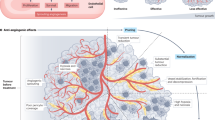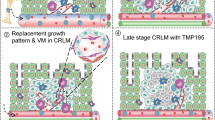Abstract
Despite the significance of tumour neoangiogenesis and the extensive knowledge on the molecular basis of blood vessel formation currently no quantitative data exist on the 3D microvascular architecture in human primary tumours and their precursor lesions. This prompted us to examine the 3D vascular network of normal colon mucosa, adenomas and invasive carcinomas by means of quantitative microvascular corrosion casting. Fresh hemicolectomy specimens from 20 patients undergoing cancer or polyposis coli surgery were used for corrosion casting, factor VIII and VEGF immunostaining. In addition, immunostaining was done on colorectal tissue from 33 patients with metastatic and non-metastatic carcinomas, polyposis coli and adenomas. This first quantitative analysis of intervessel and interbranching distances, branching angles and vessel diameters in human cancer specimens revealed distinct patterns of the microvascular unit in the tumour centre and periphery. Irrespective of the tumour localization and grading all individual tumours displayed qualitatively and quantitatively the same vascular architecture. This gives further evidence for the existence of a tumour type-specific vascular architecture as recently demonstrated for experimental tumours. Metastatic tumours displayed different vascular architectures only within hot spots, in terms of smaller intervascular distances than in non-metastatic tumours. Pre-cancerous lesions have in part virtually the same vascular architecture like invasive carcinomas. Comparison of VEGF immunostaining also suggests that angiogenesis sets in long before the progress towards invasive phenotypes and that the so-called angiogenic switch is more likely a sequence of events. © 2001 Cancer Research Campaign
Similar content being viewed by others
Article PDF
Change history
16 November 2011
This paper was modified 12 months after initial publication to switch to Creative Commons licence terms, as noted at publication
References
Ajiki T, Fujimori T, Ikehara H, Saitoh Y and Maeda S (1995) K-ras gene mutation related to histological atypias in human colorectal adenomas. Biotech Histochem 70: 90–94
Arbiser JL, Moses MA, Fernandez CA, Ghiso N, Cao Y, Klauber N, Frank D, Brownlee M, Flynn E, Parangi S, Byers HR and Folkman J (1997) Oncogenic H-ras stimulates tumor angiogenesis by two distinct pathways. Proc Natl Acad Sci USA 94: 861–866
Carmeliet P (2000) Mechanisms of angiogenesis and arteriogenesis. Nat Med 6: 389–395
Fait E, Gnoth SH, Dimitropoulou C, Gaumann A, Kirkpatrick CJ, Junginger T and Konerding MA Microvascular patterns of the human large intestine: Morphometric studies of vascular parameters in corrosion casts. Scanning Microsc,
Folkman J (1976) The vascularization of tumors. Sci Am 234: 58–63
Folkman J (1995) Angiogenesis in cancer, vascular, rheumatoid and other disease. Nat Med 1: 27–31
Folkman J and D’Amore PA (1996) Blood vessel formation: what is its molecular basis? (comment). Cell 87: 1153–1155
Folkman J, Watson K, Ingber D and Hanahan D (1989) Induction of angiogenesis during the transition from hyperplasia to neoplasia. Nature 339: 58–61
Herlyn M, Clark WH, Rodeck U, Mancianti ML, Jambrosic J and Koprowski H (1987) Biology of tumor progression in human melanocytes. Lab Invest 56: 461–474
Ishikawa H, Fujii H, Yamamoto K, Morita T, Hata M, Koyama F, Terauchi S, Sugimori S, Kobayashi T, Enomoto H, Yoshikawa S, Nishikawa T and Nakano H (1999) Tumor angiogenesis predicts recurrence with normal serum carcinoembryonic antigen in advanced rectal carcinoma patients. Surg Today 29: 983–991
Jain RK (1988) Determinants of tumor blood flow: a review. Cancer Res 48: 2641–2658
Jakob W, Jentzsch KD, Mauersberger B and Oehme P (1977) Demonstration of angiogenesis-activity in the corpus luteum of cattle. Exp Pathol (Jena) 13: 231–236
Kitadai Y, Haruma K, Tokutomi T, Tanaka S, Sumii K, Carvalho M, Kuwabara M, Yoshida K, Hirai T, Kajiyama G and Tahara E (1998) Significance of vessel count and vascular endothelial growth factor in human esophageal carcinomas. Clin Cancer Res 4: 2195–2200
Konerding MA, Miodonski AJ and Lametschwandtner A (1995) Microvascular corrosion casting in the study of tumor vascularity: a review. Scanning Microsc 9: 1233–1243
Konerding MA, Fait E, Dimitropoulou C, Malkusch W, Ferri C, Giavazzi R, Coltrini D and Presta M (1998) Impact of fibroblast growth factor-2 on tumor microvascular architecture. A tridimensional morphometric study. Am J Pathol 152: 1607–1616
Konerding MA, Malkusch W, Klapthor B, van Ackern C, Fait E, Hill SA, Parkins C, Chaplin DJ, Presta M and Denekamp J (1999) Evidence for characteristic vascular patterns in solid tumours: quantitative studies using corrosion casts. Br J Cancer 80: 724–732
Malkusch W, Konerding MA, Klapthor B and Bruch J (1995) A simple and accurate method for 3-D measurements in microcorrosion casts illustrated with tumour vascularization. Anal Cell Pathol 9: 69–81
Millauer B, Shawver LK, Plate KH, Risau W and Ullrich A (1994) Glioblastoma growth inhibited in vivo by a dominant-negative Flk-1 mutant. Nature 367: 576–579
Okada F, Rak JW, Croix BS, Lieubeau B, Kaya M, Roncari L, Shirasawa S, Sasazuki T and Kerbel RS (1998) Impact of oncogenes in tumor angiogenesis: mutant K-ras up-regulation of vascular endothelial growth factor/vascular permeability factor is necessary, but not sufficient for tumorigenicity of human colorectal carcinoma cells. Proc Natl Acad Sci USA 95: 3609–3614
Smith-McCune KK and Weidner N (1994) Demonstration and characterization of the angiogenic properties of cervical dysplasia. Cancer Res 54: 800–804
Takahashi Y, Tucker SL, Kitadai Y, Koura AN, Bucana CD, Cleary KR and Ellis LM (1997) Vessel counts and expression of vascular endothelial growth factor as prognostic factors in node-negative colon cancer. Arch Surg 132: 541–546
Takahashi Y, Bucana CD, Cleary KR and Ellis LM (1998) p53, vessel count, and vascular endothelial growth factor expression in human colon cancer. Int J Cancer 79: 34–38
Weidner N, Semple JP, Welch WR and Folkman J (1991) Tumor angiogenesis and metastasis-correlation in invasive breast carcinoma. N Engl J Med 324: 1–8
Weidner N, Folkman J, Pozza F, Bevilacqua P, Allred EN, Moore DH, Meli S and Gasparini G (1992) Tumor angiogenesis: a new significant and independent prognostic indicator in early-stage breast carcinoma (see comments). J Natl Cancer Inst 84: 1875–1887
Weidner N, Carroll PR, Flax J, Blumenfeld W and Folkman J (1993) Tumor angiogenesis correlates with metastasis in invasive prostate carcinoma. Am J Pathol 143: 401–409
Wong MP, Cheung N, Yuen ST, Leung SY and Chung LP (1999) Vascular endothelial growth factor is up-regulated in the early pre-malignant stage of colorectal tumour progression. Int J Cancer 81: 845–850
Yancopoulos GD, Klagsbrun M and Folkman J (1998) Vasculogenesis, angiogenesis, and growth factors: ephrins enter the fray at the border (comment). Cell 93: 661–664
Author information
Authors and Affiliations
Rights and permissions
From twelve months after its original publication, this work is licensed under the Creative Commons Attribution-NonCommercial-Share Alike 3.0 Unported License. To view a copy of this license, visit http://creativecommons.org/licenses/by-nc-sa/3.0/
About this article
Cite this article
Konerding, M., Fait, E. & Gaumann, A. 3D microvascular architecture of pre-cancerous lesions and invasive carcinomas of the colon. Br J Cancer 84, 1354–1362 (2001). https://doi.org/10.1054/bjoc.2001.1809
Received:
Revised:
Accepted:
Published:
Issue date:
DOI: https://doi.org/10.1054/bjoc.2001.1809
Keywords
This article is cited by
-
99mTc-MAA accumulation within tumor in preoperative lung perfusion SPECT/CT associated with occult lymph node metastasis in patients with clinically N0 non-small cell lung cancer
BMC Cancer (2023)
-
Noninvasive prediction of axillary lymph node breast cancer metastasis using morphometric analysis of nodal tumor microvessels in a contrast-free ultrasound approach
Breast Cancer Research (2023)
-
Hybrid high-definition microvessel imaging/shear wave elastography improves breast lesion characterization
Breast Cancer Research (2022)
-
Volumetric imaging and morphometric analysis of breast tumor angiogenesis using a new contrast-free ultrasound technique: a feasibility study
Breast Cancer Research (2022)
-
Ultrasound high-definition microvasculature imaging with novel quantitative biomarkers improves breast cancer detection accuracy
European Radiology (2022)



